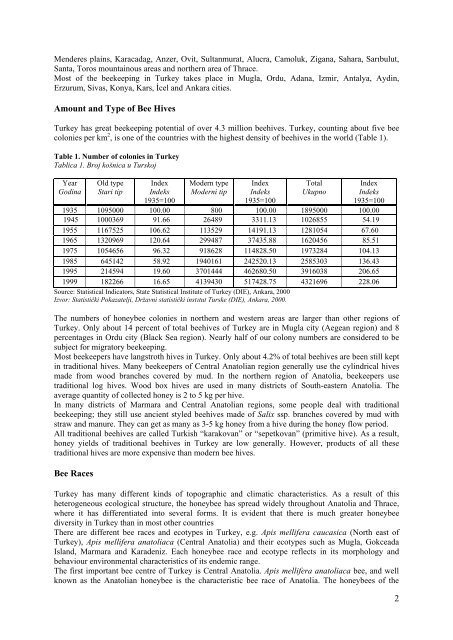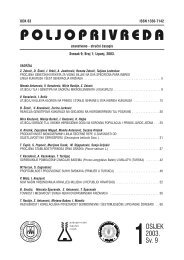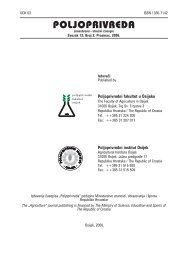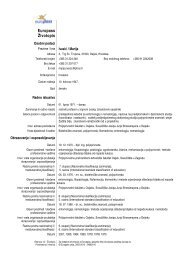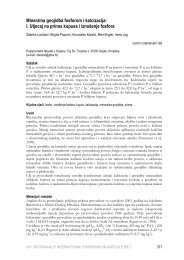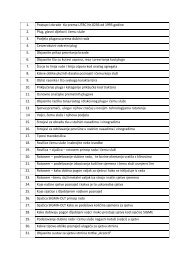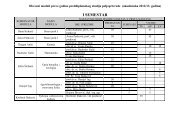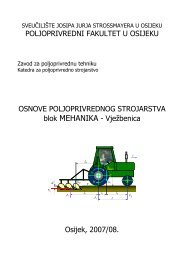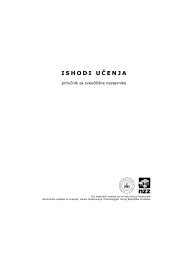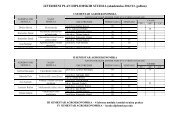1 THE GENERAL APICULTURAL SITUATION OF TURKEY ...
1 THE GENERAL APICULTURAL SITUATION OF TURKEY ...
1 THE GENERAL APICULTURAL SITUATION OF TURKEY ...
Create successful ePaper yourself
Turn your PDF publications into a flip-book with our unique Google optimized e-Paper software.
Menderes plains, Karacadag, Anzer, Ovit, Sultanmurat, Alucra, Camoluk, Zigana, Sahara, Sarıbulut,<br />
Santa, Toros mountainous areas and northern area of Thrace.<br />
Most of the beekeeping in Turkey takes place in Mugla, Ordu, Adana, Izmir, Antalya, Aydin,<br />
Erzurum, Sivas, Konya, Kars, İcel and Ankara cities.<br />
Amount and Type of Bee Hives<br />
Turkey has great beekeeping potential of over 4.3 million beehives. Turkey, counting about five bee<br />
colonies per km 2 , is one of the countries with the highest density of beehives in the world (Table 1).<br />
Table 1. Number of colonies in Turkey<br />
Tablica 1. Broj košnica u Turskoj<br />
Year<br />
Godina<br />
1935 1095000 100.00 800 100.00 1895000 100.00<br />
1945 1000369 91.66 26489 3311.13 1026855 54.19<br />
1955 1167525 106.62 113529 14191.13 1281054 67.60<br />
1965 1320969 120.64 299487 37435.88 1620456 85.51<br />
1975 1054656 96.32 918628 114828.50 1973284 104.13<br />
1985 645142 58.92 1940161 242520.13 2585303 136.43<br />
1995 214594 19.60 3701444 462680.50 3916038 206.65<br />
1999 182266 16.65 4139430 517428.75 4321696 228.06<br />
Source: Statistical Indicators, State Statistical Institute of Turkey (DIE), Ankara, 2000<br />
Izvor: Statistički Pokazatelji, Državni statistički instıtut Turske (DIE), Ankara, 2000.<br />
The numbers of honeybee colonies in northern and western areas are larger than other regions of<br />
Turkey. Only about 14 percent of total beehives of Turkey are in Mugla city (Aegean region) and 8<br />
percentages in Ordu city (Black Sea region). Nearly half of our colony numbers are considered to be<br />
subject for migratory beekeeping.<br />
Most beekeepers have langstroth hives in Turkey. Only about 4.2% of total beehives are been still kept<br />
in traditional hives. Many beekeepers of Central Anatolian region generally use the cylindrical hives<br />
made from wood branches covered by mud. In the northern region of Anatolia, beekeepers use<br />
traditional log hives. Wood box hives are used in many districts of South-eastern Anatolia. The<br />
average quantity of collected honey is 2 to 5 kg per hive.<br />
In many districts of Marmara and Central Anatolian regions, some people deal with traditional<br />
beekeeping; they still use ancient styled beehives made of Salix ssp. branches covered by mud with<br />
straw and manure. They can get as many as 3-5 kg honey from a hive during the honey flow period.<br />
All traditional beehives are called Turkish “karakovan” or “sepetkovan” (primitive hive). As a result,<br />
honey yields of traditional beehives in Turkey are low generally. However, products of all these<br />
traditional hives are more expensive than modern bee hives.<br />
Bee Races<br />
Old type<br />
Stari tip<br />
Index<br />
Indeks<br />
1935=100<br />
Modern type<br />
Moderni tip<br />
Index<br />
Indeks<br />
1935=100<br />
Total<br />
Ukupno<br />
Index<br />
Indeks<br />
1935=100<br />
Turkey has many different kinds of topographic and climatic characteristics. As a result of this<br />
heterogeneous ecological structure, the honeybee has spread widely throughout Anatolia and Thrace,<br />
where it has differentiated into several forms. It is evident that there is much greater honeybee<br />
diversity in Turkey than in most other countries<br />
There are different bee races and ecotypes in Turkey, e.g. Apis mellifera caucasica (North east of<br />
Turkey), Apis mellifera anatoliaca (Central Anatolia) and their ecotypes such as Mugla, Gokceada<br />
Island, Marmara and Karadeniz. Each honeybee race and ecotype reflects in its morphology and<br />
behaviour environmental characteristics of its endemic range.<br />
The first important bee centre of Turkey is Central Anatolia. Apis mellifera anatoliaca bee, and well<br />
known as the Anatolian honeybee is the characteristic bee race of Anatolia. The honeybees of the<br />
2


